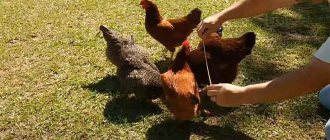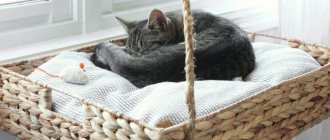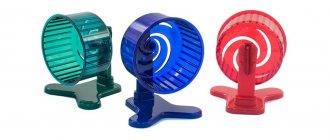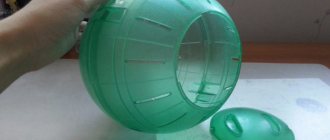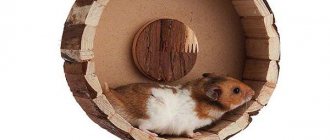- home
- Housing
13.04.2018
Hamsters are nimble animals that need a house that meets all their requirements. The necessary paraphernalia is quite expensive. Therefore, rodent owners often think about building their own housing for their pet. It is rarely possible to make a hamster cage with your own hands from available materials. But with some effort and purchasing the necessary materials, you can build a real palace. The cost of a homemade cage will be lower than a ready-made cage purchased in a store.
Simple wire cutters
The most primitive device is very similar to ordinary scissors.
Only one of its cutting surfaces is equipped with a small notch with a sharp edge. Using such a device is easy, provided you have some skill and experience. For young dogs, nail trimming is always stressful. They do not want to sit quietly, they strive to tear the paw out of the owner’s hands and in every possible way complicate the process. So Litbro.ru will not recommend such a gadget to novice dog breeders. The risk of causing serious physical injury to your pet is too great. Well, for experienced owners who have used similar tools more than once, nothing better can be desired. Cheap and very effective. Cost – 35 – 72 rubles.
More advanced versions of hand cutters offer expanded functionality.
Although their main part, in the old fashioned way, is based on two cutting surfaces. Service additions imply only human convenience. Models with rounded ends, a container for cut claws and lighting have proven themselves very well. The fact is that some dogs have the habit of looking for clipped ends on the floor and eating them. Sharp, bent cuttings can damage the stomach wall and cause bleeding. A small “waste collection” effectively solves this problem.
Price – 636 rub.
Another gadget from the line of simple nippers has comfortable ergonomic handles that allow you to securely hold the tool while trimming nails.
This is important when the animal gets nervous and breaks out.
We pay attention to one more detail - the expansion spring. It fixes the cutting surfaces in the open state, which makes the operation somewhat easier.
Otherwise, the functions of the device duplicate all the features of its predecessors. To properly shorten claws, you must have the skill and achieve unquestioning obedience from your dog or cat.
Cost – 229.93 rubles.
Why does a ferret need a hammock?
Beginning ferret breeders are often surprised to learn that their pet needs a hammock, and not an ordinary bed, for a comfortable existence and sweet sleep.
Animals can sleep in boxes, on pillows, in their house, and even crawling into a warm sock or felt boot, but only a hammock allows a ferret to feel completely safe. This is due to the fact that wild relatives of domesticated ferrets always choose secluded dark places to sleep - under a stump, in dense bushes, or dig holes. Soft earth or grass perfectly takes the shape of the animal’s body, and it feels protected both from enemies and from bad weather.
Domestic ferrets living in an apartment do not have the opportunity to dig a hole for themselves, and the presence of a sleeping place, the same as dry leaves or grass, makes the pet happy - he sleeps well, so he plays and “hunts” with great pleasure.
Peculiarities
Hamsters in the wild prefer to settle in small shelters (nests), choosing for this purpose recesses, burrows and hollows. They provide the animals with the necessary thermoregulation, comfort and safety. As for domestic animals, the arrangement of their housing depends entirely on the care of the owners, who usually purchase a compact house for the hamster and complement it with various accessories for “walks” and games.
Since hamsters are rodents, it is advisable to choose wooden or plastic cages with an entrance and a removable lid as housing for them.
In addition, the house must be spacious, since animals love to hide their food supplies. The main requirements for the operation of a hamster’s home include safety, so the structure in which it is planned to keep the fluffy must be stable and not have sharp corners at the edges.
Why do you need a trainer?
Hamsters, by nature, are nocturnal rodents. Under natural conditions, animals run long distances in order to feed themselves. Hamsters kept at home are deprived of this opportunity. In addition, there is simply no particular need to independently search for and obtain food, since timely and sufficient feeding of the pet is provided by its owner.
But despite favorable conditions and satiety, hamsters still need to periodically receive physical activity. This is necessary not only to entertain the animal, but also to maintain the health of its cardiovascular system. Regular physical activity stimulates the rodent's metabolism and metabolism, helping to keep the muscular system in good shape.
And in a small cage, you need to give the hamster the opportunity to move, because it is not safe to let him roam freely. Due to its small size, the animal is not very visible and can be accidentally injured. But other pets can also be dangerous for hamsters: cats, dogs, large parrots.
A convenient and safe solution to this problem is to install a running wheel directly in your pet’s home. Hamsters quickly understand how to use it, and if they want, they can climb onto the simulator and run around at any time.
The only drawback is that the hamster is a nocturnal animal. That is, its activity in most cases occurs at the time of day when we are used to sleeping. Therefore, active night runs can disturb apartment dwellers if the wheel squeaks or makes a knocking sound.
Features of buildings for Dzungarian and Syrian breeds
Each hamster house should be designed taking into account the size and habits of your furry pet. It is important that the active and nimble dwarfs have the opportunity to play; the rodents should be comfortable and safe in the house. Djungarian or Syrian hamsters need material to build a nest; it must be soft and environmentally friendly. It can be cotton wool, napkins, but not newspaper - the lead alloy for casting typographic fonts is dangerous for animals.
It is also necessary to take into account that small animals can escape from the house through cracks caused by poor-quality fastening of parts during manufacturing; chew a hole, finding its weak point. And larger Syrian hamsters can get stuck in a tunnel opening that is too narrow, which can be very frightening for them. Therefore, you need to take into account all the little things and constantly check your home.
How often to clean your home
In order to maintain a healthy, favorable atmosphere inside the cage, it is necessary to regularly clean it. As mentioned above, every day you should spot clean bedding material that is contaminated with rodent excrement, food or plain water. Thorough cleaning of the home is carried out every 2–4 weeks.
Cleaning the cage includes several steps:
- remove the hamster and transfer it to a jar or other container;
- change the bedding to a new and clean one, leaving some of the bedding so that the hamster’s smell does not disappear completely;
- Wash the tray with warm water using baby detergents or special preparations;
- Using a regular sponge soaked in water, wipe the rods. Wipe all accessories with a dry cloth.
Video: cleaning a hamster cage
Important! It is better not to touch the food reserves hidden by the pet - if they are not found, the dwarf can experience a great shock. You only need to remove spoiled foods that can poison your hamster
Possible problems and ways to solve them
Hamster doesn't sleep in the house
Reasons why a hamster does not sleep in the house:
- the material or bedding causes allergies or is unpleasant for the pet;
- the animal did not understand the purpose (to eliminate the problem in this case, you can put an object with an already familiar smell in the house);
- the pet uses it to store food;
- the entrance to the house is inconvenient;
- the animal feels unsafe in it (transparent walls, large holes);
- no ventilation;
- closely;
- doesn’t want to (in this case you just need to give him time to get used to it).
What can you use at home?
The materials from which accessories for rodents are made must be as safe as possible. The owner must think two steps ahead and consider the consequences if the hamster chews the toy.
To make toys and leisure items you can use:
- Various cardboard plastic boxes.
- Empty, clean plastic bottles.
- PVC pipe cuttings.
- Wood, plywood, craigs.
- Popsicle sticks.
- Durable fabric - jeans, linen, burlap.
To work with cardboard and paper you will need:
- Sharp scissors and a stationery knife.
- Strong threads, preferably nylon.
- Clean thin paper.
- Stationery PVA glue.
To work with plastic bottles and PVC pipes you will need:
- Sharp stationery knife.
- An old knife that can be heated.
- Glue gun.
- Fabric based adhesive tape.
- If you have long pieces of pipe left, you will need a hacksaw with a thin blade.
To work with wood you need to have on hand:
- Hacksaw.
- Drill.
- Wooden chops.
- High-quality PVA wood glue.
- Wooden corners.
Required Tools
All the materials needed for manufacturing are available in almost every home.
You may need:
- a clean plastic container with a tight-fitting lid, size 30x30 cm;
- large 10 liter water bottle;
- wooden box;
- wire mesh;
- nuts, bolts and washers to attach the mesh to the cover;
- wooden slats;
- wooden panel materials;
- long piece of wire;
- wire cutters;
- drill and drill bits size 11/64;
- utility knife with a sharp blade;
- saw;
- marker;
- roulette.
Important! Whatever cage you choose, make sure there are no jagged edges that could hurt your hamster and that you have covered all possible escape routes.
How to make a tunnel for a hamster with your own hands
You can buy tunnels at a pet store or make your own. What are these structures made of:
- plastic bottles;
- toilet paper rolls;
- boxes;
- plumbing pipes.
The choice depends on the size of the animal, the materials at hand and the flight of fancy.
Tunnels for hamsters made from plastic bottles
The advantages of such structures include their safety and accessibility. Food grade plastic bottles of 1.5 and 2 liters are perfect for homemade tunnels. The choice of volume depends on the size of the hamster: 1.5 liters is enough for a Djungarian hamster, a 2 liter bottle is required for a Syrian.
To work you need a stationery knife, scissors and electrical tape. The design consists of identical nodes arranged in random order. Each node consists of two bottles, one of which “pierces” the other at a right angle. Take two bottles:
Cut two holes in one of them just below the neck. One should be small, the neck of the second bottle will fit into it, and the other should be larger, the wide part will be attached there.
Make a hole in the second bottle through which the hamster will get into it from the first.
“Pull” the second bottle through the first so that only the neck goes through.
Place the cap on the neck and screw it on. The result was a knot of two connected bottles. Make the second knot from the second and another - third bottle. Make two holes for fastening the third bottle, stepping back slightly from the bottom of the second bottle. And then, just like the first node.
Connect the lower parts 2 and 3 of the bottle with any number of nodes in any direction. In the middle of the first bottle, make an entrance for the hamsters, attach a bottle cut in half to it.
Cover the cut edges with electrical tape to prevent the animals from getting hurt.
Single-story or multi-story: what to choose?
The classic option is a one-story metal cage. It is easy to disassemble, convenient and quick to clean. This design can be additionally equipped with a tunnel or pen: the dwarf will have more room to run.
The second option is a cage of several floors. For such a house there are a number of additional requirements.
The distance between floors is from 17 to 25 cm. If the height is more than 30 cm, the level of injury risk increases.
The floor must be solid plastic, since food, bedding and the rodent’s paws will fall through the grate when running
Please note that the cages have height-adjustable tiers.
So which option is better? It is recommended that Djungarian hamsters choose single-story cages with a large area. Individuals love jogging and free space. This is much more interesting for them than climbing or climbing up bars.
Electric models
Beginners should pay attention to more innovative gadgets. They are definitely a little more expensive
But in this case, the price increase proportionally affects safety.
We are talking about a family of rechargeable machines equipped with a rotating head. They do not cut, but grind down the cornea. With this approach, it is almost impossible to harm a dog or cat by catching too much of a nail. The high rotation speed of the tip ensures fast operation, and the low noise level does not bother four-legged patients at all. Any beginner can easily cope with such a mechanism.
Price – 481 – 1,859 rubles.
Some models are equipped with 2-3 heads, suitable for dogs or cats of various breeds and age groups.
After all, the claws of a dwarf poodle are much more delicate than those of a German shepherd. The same applies to young kittens and adult cats - their paws need to be treated with different elements. So, when purchasing a tool for trimming claws, you should consider this nuance.
Cost – 567 – 1,189 rubles.
The final touch is the rotation speed of the device head.
It directly affects the quality of claw grinding. After all, it is necessary not only to cut off the ends, but also to polish the ends so that the sharp edges do not injure the delicate pads of the paws. This operation is best done in a more gentle mode at low speeds. So a machine with gear shifting will come in very handy in this case.
Price – 497 – 1,566 rubles.
I like it I don't like it
Cages with tunnels for hamsters
In modern cages, manufacturers try to add tunnels for the convenience of the animals. These additions implicitly increase cage space, giving the hamsters more artificial tracks to run on.
The tunnels themselves are on sale, from which you can build a convenient structure. Tunnels can connect 2 adjacent cells, or can be used as a transition to the second floor.
Is there a ready-made hamster cage with a labyrinth on sale? Perhaps there is. But what is a cage maze? This is a structure made of many tunnels. Most likely, you will have to make it to order, which is quite expensive. There is a way out, buy separate tunnels and attach them to the cage. Another option is a hamster cage with pipes. Pipes can be attached to the bars of the cage and taken outside the cage.
Tips for caring for your cage
Experienced breeders willingly shared with us some secrets that will make caring for a hamster simple and easy.
First of all, you don’t need to pour food too generously, especially for raw vegetables and fruits, as well as protein products. They quickly deteriorate, an unpleasant odor appears in the cage, and you will have to clean it more often. Not to mention the fact that spoiled food can poison your pet.
Don't throw away your hamster's supplies. The pantry is sacred for a pet. Not only his good mood, but also his well-being depends on its presence. If the owner constantly throws out NC, the hamster may become aggressive or, conversely, apathetic and refuse to communicate. The presence of a house and supplies in it is the key to the physical and mental health of the animal. You just need to make sure that there are no perishable products in your supplies.
The subject of particular concern for the owners is cleaning the toilet. Usually the hamster allocates a special area in the cage to relieve itself. To minimize the likelihood of an unpleasant odor, you can carefully remove this particular area of the litter every 2-3 days and add new litter, and completely change it every 6-8 days.
As you can see, there is nothing complicated in arranging a home for a furry pet. Take care of him, pay at least a little attention every day, and the hamster will invariably please you and give you a good mood.
Master classes on making toys
In order for your “fluffy” not to be sad, it is not at all necessary to buy him expensive toys; all the things for a pleasant pastime of the hamster, with which he will happily play, can be made independently, with your own hands.
Homemade staircase
Very often, hamsters chew through the wheel in the form of a lattice. But don’t rush to throw it away after that - it will make an excellent staircase that you can make with your own hands.
The excess spokes on the sides of the wheel are cut off, then the ring is opened and the crossbars are cut off one at a time. Using a lighter, the middle of the former wheel is slightly melted to the point of creating a bowing bridge. The edges of the ladder are also heated over an open fire and bent like hooks so that the product can be easily hung in the cage.
Tunnel
Hamsters love to climb into narrow spaces. You can make a homemade tunnel with your own hands from wood or even from ordinary durable cardboard and electrical tape.
The cardboard is bent into a tube of such a diameter that a hamster can freely crawl into it. To keep this tube in place, tape its edges. It is better to secure the resulting tunnel with electrical tape at the bottom of the cage so that it is convenient for the hamster to get through it.
Two-story house
To create a house you will need wood plywood, preferably poplar. The dimensions of the roof will be 25 by 12 cm, the walls will be 10 by 10 cm, except for the back, which will be 25 by 10 cm.
A hole is made in the first side, and an opening for the valve is marked on the second and rear. Now blanks are cut out using the marked material and glued together. We fix the roof and turn the created structure over. From the inside we mark places for future slats and glue them.
To create a second floor, a hole is made in the roof and a smaller box glued together from the same plywood is placed.
Maze and obstacles
An obstacle maze can be one of the most entertaining and long-lasting entertainment for your pet, a place where he can play. And it’s quite simple to do. Along the way, it is better to place not only obstacles, but also tasty treats.
To create a labyrinth with your own hands, you will need a decent-sized cardboard box, paper with a beautiful ornament, wooden borders, a measuring ruler, glue, and scissors.
The walls will be about 15 cm, just enough to prevent the hamster from climbing over them. It is at this level that we cut off the box from above, and then make one exit. For beauty from the inside, it is better to cover the structure with decorative paper.
Now you need to make the inner walls of the labyrinth from curbs or plywood. To secure them, it is better not to use PVA glue, since in this case the hamster can simply break the walls while running around. Obstacles can be small slides made of the same plywood or tunnels in the form of twisted cardboard. You need to wait until the glue dries and place tasty treats for the hamster in different parts of the structure so that he is more willing to explore the entire maze and eventually find a way out of it.
House for a rat made of wood.
Wood is the best material for a rodent's house. There are several reasons for this. The first reason is that the material is environmentally friendly, the second reason is that it does not harm the pet when it sharpens its teeth.
However, there are also disadvantages. The main disadvantage is that wood easily absorbs moisture (rat feces), begins to smell bad and becomes completely unhygienic. Such a house should be thoroughly washed periodically, and over time it will have to be completely replaced with a new one.
Creating a wooden house is a creative process and you can make it of any shape and type. But do not forget that not any wood is suitable for a rodent. Some tree varieties are not only unhealthy, but also toxic. Wood from fruit tree varieties is best suited:
- pear,
- Apple tree,
- Rowan,
and wild ones are also suitable:
- Linden,
- birch,
- oak, etc.
Before you start working, the material should be subjected to heat treatment (put in the oven for a couple of minutes at a temperature of 100°C or boil in boiling water). This will rid the tree of any remaining parasites.
Which cage to buy for rodents
| Model name | Characteristics | pros | Minuses | Approximate price in rubles |
| Ferplast Criceti 9 Princess | 46x29.5x22.5 cm, pink solid tray, covered with colored stickers, lacquered metal mesh on a plastic base, complete with feeder, drinking bowl, nest, large running wheel and decoration. | Top door with safety closing system, beautiful, mesh and bottom are easy to separate, durable. | Low, small diameter wheel. | 2195 |
| Ferplast Criceti 11 | 57.5x31x23 cm, blue and black tray, complete with house, food mix, running wheel, drinking bowl with fastenings. | Comfortable living conditions, roomy, the bottom is easily separated from the top, the tray is high. | Large distance between the rods. | 2395 |
| Ferplast Oriente 10 | 49.5x31.5x25.7 cm, you can choose a pink or gray tray, a running wheel, a feeder, a drinking bowl, and a house are included. | Original design in oriental style, well ventilated. | Wide grille openings. | 2700 |
| Credo M 02 | 33.5x25x28 cm, assorted white, green, pink, blue, red, lilac, complete with feeder, slide, drinking bowl, running wheel with counter. | Beautiful, looks great in photos and in person, lots of entertainment for the animal. | There is a large distance between the rods. | 1770 |
| Credo M 021 | 45x30x33 cm, 2 floors, there is a feeder, an automatic drinker, a screw descent, a house, a running wheel, available in white, red, pink, blue, green. | Spacious, durable, made of quality materials. | The door opens from the side. | 1840 |
| Credo M 022 | 45x30x45 cm, 3 levels, 2 additional floors, wheel, automatic drinker, descent, feeder. | The plastic tray is easy to clean, the grill bars do not bend, there is a lot of free space. | Not suitable for a small hamster. | 2115 |
| FOP Zoe | 45x27x20 cm, blue tray, horizontal bars on a lattice, house, wheel, feeder included. | Durable, easy to disassemble and clean, made of absolutely safe materials. | Small. | 1800 |
| Cage for Djungarian hamsters “Zoonik” | 22.5x16.5x21 cm, complete with wheel and bowl, plastic tray, horizontal grid made of painted metal. | It's cheap. | Very little. | 435 |
| IPTS Alex | 58x38x25 cm, blue tray, made of plastic and metal, has a wheel, drinker, feeder. | Reliable latches, large area, very convenient to feed hamsters. | The drinking bowl may leak, poor ventilation, high cost. | 3110 |
| Cage "Zoomark" | 36x23x24 cm, complete with hamster cage with tray, wheel, ladder, house | Many colors, cheap. | The set does not include a drinking bowl or feeder. | 825 |
Which option to choose for the house
Before you build a house for a hamster with your own hands, you need to decide what it should be like. The purpose of such a home is to hide the pet from prying eyes. When deciding what to make a house from, you need to give preference to non-toxic materials, since the animal will definitely try them. Housing must be cleaned periodically.
A house for any hamster can be made of paper or cardboard. Boxes, slats, plywood and coconut are also suitable for this. There are various design ideas that allow you to turn your pet’s home into a real interior decoration.
How to make a cozy house for a hamster with your own hands largely depends on its size. And they are selected taking into account the size of the animal. A Syrian pet will need a larger home than a Djungarian pet.
A good shelter will not only provide an excellent place to sleep, but also provide protection from drafts. You can make different houses for hamsters, the photo shows interesting options for such designs.
Wooden house
Let's consider the option of building a wooden house for a hamster
It is important to choose a length so that the animal does not feel cramped, and there is also enough space for storing food supplies. In addition, it is necessary that the animal can climb around its apartment. It is important that the structure has ventilation
To do this, several holes are made in the surface. All parts and holes must be carefully sanded so that the pet does not get hurt.
It is important that the structure has ventilation. To do this, several holes are made in the surface. All parts and holes must be carefully sanded so that the pet does not get hurt. Now let's figure out how to make a house for a hamster with your own hands
First of all, you need to prepare a wooden board or sheet of plywood. A house made of plywood will cost less. And this material is easier to process. The approximate height of a wooden building should be 10 cm. The lower part is left open. For the top, you need to set aside 17*12 cm on the sheets. This will prevent the roof from falling inward. A window and entrance are cut out on the front surface. To fix parts, you can use slats
Now let's figure out how to make a house for a hamster with your own hands. First of all, you need to prepare a wooden board or sheet of plywood. A house made of plywood will cost less. And this material is easier to process. The approximate height of a wooden building should be 10 cm. The lower part is left open. For the top, you need to set aside 17*12 cm on the sheets. This will prevent the roof from falling inward. A window and entrance are cut out on the front surface. To fix parts, you can use slats.
The assembly process consists of the following steps:
- Each part must be processed with a file and then sanded with sandpaper.
- The walls are assembled with self-tapping screws or nails.
- The roof is placed on top without fixing, which makes it easy to clean the room.
Housing out of a box
By analogy with a wooden house, you can make a house out of a box. First, suitable patterns should be made from cardboard. The walls are secured with some kind of safe glue. The window and entrance are made using scissors or a stationery knife.
You can also make a house out of a tissue box. Such containers already have holes that will be used as an entrance.
House made of bottles
You can build a nice house out of bottles. Here's what to do:
- The bottom of the bottle is cut off. Then it is turned over with the cut down and the entrance is made in a semicircle.
- It is necessary to make holes for ventilation along the perimeter of the product with a hot knitting needle.
- The cut edges of the bottle must be treated with electrical tape to prevent injury to the animal.
Coconut option
If you don’t like the previous options, then you can figure out how to make a house out of a coconut. This option is not difficult, but you will have to scrape the pulp out of the fruit. The dwelling is more suitable for a dzhungarik.
To make a coconut house you need to follow these steps:
- Make holes in the eyes of the coconut and pour out the milk.
- The most vulnerable spot is located next to the eyes; there you need to tap with the blunt side of the knife. If a crack forms, the part can be cut off with a knife, and if not, then sawed off.
- To make it easy to remove the pulp, the fruit is placed in the freezer for half an hour.
- An arch is cut out on one side. The edges of the holes for entry and ventilation need to be sanded.
The coconut house is installed with the hole cut down. This will prevent the structure from rolling.
Tips and tricks
In addition to the basic rules for building a hamster cage, there are additional recommendations that are no less important:
- The materials used must first be thoroughly washed, disinfected and cleaned of excess - stickers, paint residues.
- Before starting work, you need to think about the structure of the cage: plan the toilet, feeding areas, a free part for games and physical training, as well as a place for the hamster to sleep and rest. All basic things should fit inside, and large structures such as labyrinths can be brought outside.
- All parts must be firmly secured. It is better not to use small fragments or place them on the outside of the home - in a place inaccessible to the hamster.
- The cage must be made in such a way that its design does not interfere with regular cleaning. You can make it partially removable, which is especially important for multi-level houses.
- A lightweight house made of plastic or bottles can be used as a carrier.
- For large and heavy housing, it is worth making additional reinforcements between the main part and the pallet. Under heavy weight, the sides of the bottom may become deformed, causing the cage to fall.
- Locks must close doors securely.
- When constructing the cage, it is allowed to use glue, but all parts must dry before moving the pet. It takes about a week for complete drying.
- Hamster cages should be placed on a flat, stable surface, such as a low table. The house can be placed in the corner of the room or on an insulated balcony.
- When making a house, you can use a ready-made frame - an unnecessary cabinet or cabinet.
Making a hamster cage with your own hands will require some effort and construction skills. Such a house will not only be cheaper than a purchased one, but will also meet the technical requirements and personal ideas of the owners about an ideal home for pet rodents.
Vintage basket
Here we are dealing with a representative design in the style of modern rural fashion. Best suited for lovers of cycling or short distance travel on scooters. The basket itself is woven from flexible willow and equipped with an openwork wire lid, which prevents the cat from wanting to get out while moving. At the first glance at such a carrier, one is reminded of idyllic pictures from centuries ago, when food from the market was transported in a similar way on bicycles. The entire structure is conveniently attached to the steering wheel using leather straps and does not require much time for preparation.
The advantage of the option under consideration is, of course, its original design and originality. The downside is limited functionality. Although, if desired, the basket can be used for its intended purpose.
Price – 1,128 – 1,708 rubles.
